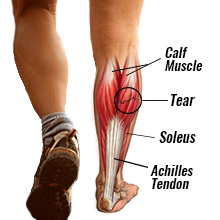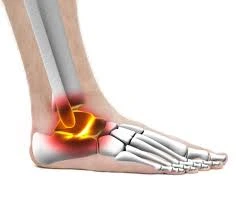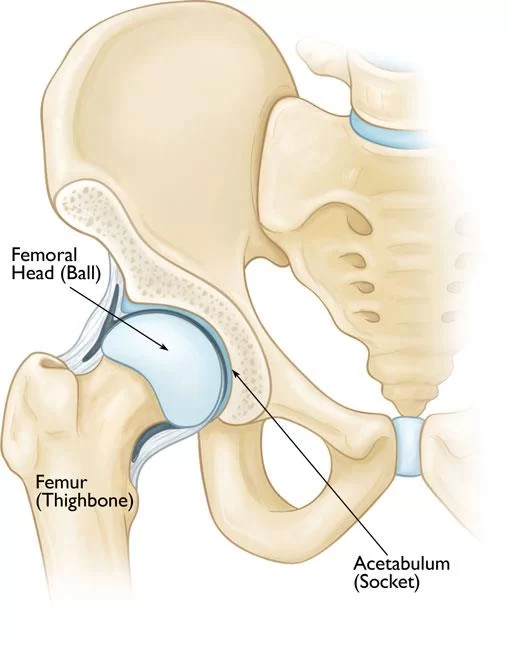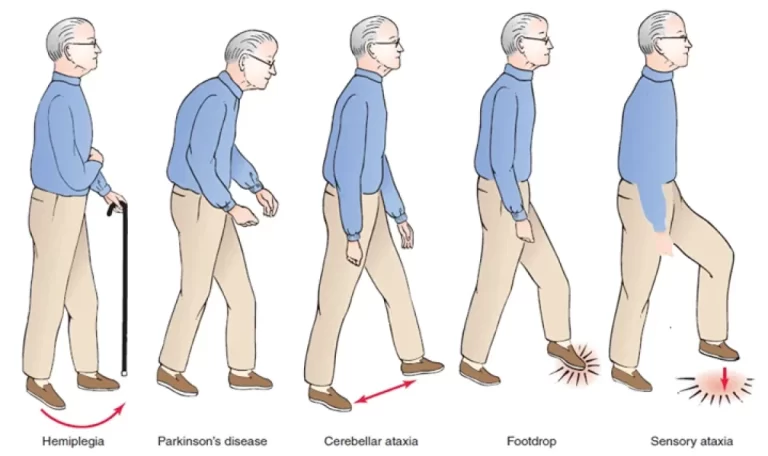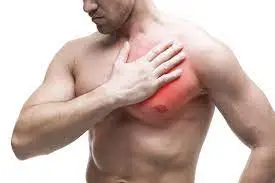Calf Muscle Tear
A torn calf muscle: what is it?
A calf muscle tear occurs when the muscles at the back of the lower leg, specifically the gastrocnemius or soleus, are overstretched or torn due to sudden or excessive force. This injury is common in athletes or individuals involved in physical activities that require rapid acceleration, jumping, or sudden changes in direction.
Symptoms typically include sharp pain, swelling, bruising, and difficulty walking or standing on the affected leg. Depending on the severity, calf muscle tears can range from mild strains to complete ruptures, requiring different levels of medical intervention and rehabilitation.
The gastrocnemius and soleus muscles are located behind the shin bone in your lower leg. They run down to your heel from behind your knee. If you overstretch these muscles with abrupt movements, they may rip. It is conceivable to sustain partial or complete (fall apart) calf muscle injuries.
Because your calf muscles are situated between the ankle and the knee, they are particularly vulnerable to rips. Additionally, these muscles are vulnerable to overstretching injuries due to their very tight muscular fibers.
What does a torn calf muscle feel like?
Consider this: Suddenly, while working out, you get a severe, stabbing ache in the back of your lower thigh. Something seems to have popped or snapped. That’s how a torn calf muscle feels. During physical action like running or leaping, it usually feels like an abrupt, intense pain in the back of the lower thigh. Some people say it sounds like a popping or snapping sound. Walking or bearing weight on that leg may become challenging, and you could also observe swelling and bruises. Without a doubt, you ought to listen to it.
Typical Reasons for Calf Muscle Tears:
Rapid actions such as running, jumping, or rapid direction changes frequently cause calf muscle injuries. These activities may overstress the calf muscles, leading to tiny tears or even whole muscle fiber ruptures. A calf muscle rupture is frequently caused by inadequate warm-up, muscular exhaustion, inappropriate footwear, and prior muscle injuries. People can also be at risk for calf muscle tears by participating in high-impact activities without the necessary fitness or by abruptly increasing their training volume.
Signs and Symptoms of Muscle Tear
The following symptoms can identify a torn calf muscle:
- Lack of calf strength, which includes the inability to wear weight on the damaged leg or balance.
- Feeling like your calf is popping or snapping.
- You feel like someone kicked your calf because of the sudden ache in the back of your lower leg.
- Your calf muscle is swollen and bruised.
- visible depression where the torn muscle is located beneath the skin.
Who experiences calf muscle tears?
Although calf muscle ruptures can happen to anybody, they are more prevalent in:
- Anyone who begins vigorous exercise without the necessary training and has short or tight calf muscles.
- Sports players who need to shift directions quickly, like those playing basketball, soccer, or tennis
- Due to aging or decreased flexibility, individuals over 40 might have less effective calf muscles.
Testing and Diagnosis of Muscle Tear:
How can a calf muscle tear be identified?
In addition to reviewing your symptoms, your healthcare professional will do a physical examination. To feel for sore or swollen spots, they could palpate, or push, on your leg muscles.
Torn calf muscles can occasionally resemble other lower limb injuries like a ruptured Achilles tendon or a burst Baker’s cyst. A major blood vessel issue like compartment syndrome or DVT may potentially be the cause of calf discomfort which seems to be muscle soreness. Your doctor may want more testing if the diagnosis is ambiguous.
To assess your calf muscles, your healthcare professional may use imaging tests:
- Doppler ultrasound: This kind of ultrasound creates images of the soft tissues within your body by using sound waves. Additionally, it monitors the flow of blood throughout your body. Your doctor can use this scan to look for internal bleeding, blood clots, and muscle tears.
- MRI: An MRI provides fine-grained pictures of your body’s soft tissues. Your doctor can use this test to distinguish between tendon and ligament issues and muscle injuries.
When Should I See a Doctor?
If you have significant calf pain, swelling, or trouble walking, it’s time to see a physician. Additionally, it’s recommended to get checked out if the discomfort doesn’t go away even after applying ice and relaxation. Additionally, don’t hesitate to get medical attention right away if you detect something really worrisome, such as a noticeable gap in your muscle or an inability to contract it correctly. Ensuring you receive the appropriate care at the appropriate time is crucial.
Treatment of Calf Muscle Tear
What is the treatment for torn calf muscles?
Your doctor may suggest the RICE at-home therapy after establishing that you have a torn calf muscle:
- Rest: Stop exercising and give your leg a break as soon as you get calf discomfort. Refrain from forcing yourself to endure discomfort as this might make it worse.
- Ice: Every two hours, apply a 20-minute cold compress or ice pack to your calf muscles.
- Compression: Cover your calf with a compression sleeve or wrap. Pressure reduces edema and blood flow to the area that hurts.
- Elevation: Raise your leg to a higher position, ideally higher than your heart. Use cushions, pillows, or blankets to support the whole length of your leg.
Until your physician provides the all-clear, avoid:
- Heat should be applied to the damaged region.
- Give your calf a massage.
- Exercise, go for a stroll, or do anything else physical.
- Additionally, you might need to wear a soft cast or boot to cover and immobilize your injuries. To walk about while their injury heals, some persons use crutches or an assistive device.
Your doctor could suggest physical therapy after a few weeks of RICE. Your calf muscles may be made stronger and more flexible with therapy. Resuming normal activities, such as ascending stairs or hitting the gas pedal in your car, may also make you feel less uncomfortable.
Muscle Tear Rehabilitation Exercises:
The kind and severity of the injury determine the rehabilitation activities for calf muscle tears. Usually, it consists of range-of-motion exercises, mild stretching, and progressively harder strengthening activities. Calf raises and other eccentric workouts are frequently recommended to aid with muscle repair and function restoration. The secret is to go slowly and steadily, as advised by your physical therapist, to ensure that you’re headed in the correct direction for a stronger recovery!
Calf Muscle Tear Recovery Exercises
Starting with simple stretches like calf stretches and ankle circles will help you become more flexible as your calf muscle rips heal. As you proceed, incorporate calf muscle tear-strengthening activities like calf raises and toe taps. To promote healing and strength restoration, progressively increase the repetitions and intensity while being closely monitored by a physical therapist. Stretches and strengthening exercises are done to ensure a consistent recovery.
Exercises for Rehabilitating Hamstring Muscle Tears
Making sure the hamstrings are safe is another popular method of treating calf muscle injuries.
Toe touches and hamstring stretches are examples of gentle stretching techniques that increase flexibility and lessen calf muscle tension. As you go through the healing process, incorporate strengthening exercises like leg curls and bridges. Under the supervision of a physical therapist, gradually increase the repetitions and intensity to aid in recovery and function restoration.
How to Avoid More Muscle Tears
Maintaining physical health and averting possible setbacks require preventing more muscle rips. Easy methods to reduce the risk of injury and enhance long-term sports performance include strength training, proper warm-up, increasing the intensity of calf muscle tear exercises gradually, and staying hydrated.
Exercises to Build Strength
Strength training is vital for calf muscle tear injuries because it promotes muscle recovery and lowers the chance of re-injury. Exercises that target the calf muscles, such as resistance band exercises, heel drops, and calf lifts, increase muscular strength, flexibility, and endurance. Additionally, it can lower the chance of future injuries.
Adaptability and Warm-Up Methods
Warm-up exercises and flexibility are crucial for lowering calf muscle injuries since they increase muscular suppleness and range of motion. Leg swings and calf stretches are examples of dynamic stretches that improve blood flow and prime muscles for action, lowering the chance of sprains or rips during exercise.
How can I avoid tearing my calf muscle?
You may lessen the chance of tearing your calf muscle by:
- letting your calf muscles relax and rehabilitate in between exercises, sessions, or games.
- keeping your calf muscles strong and well-conditioned.
- employing appropriate techniques when participating in sports.
- Before starting any physical activity, warm up and stretch your calf muscles.
- wearing well-fitting, supportive shoes.
Complications Of Muscle Tears:
- Compartment syndrome is characterized by extreme edema that stops blood flow to the muscles.
- A blood clot deep within your leg is known as deep vein thrombosis (DVT).
- Thrombophilia superficialis is a thrombus in a vein near the skin’s surface.
Prognosis and Outlook
The healing process for a torn calf muscle often takes a few weeks or months, depending on how bad the damage is. It is uncommon, but some patients still have persistent calf discomfort after their injury has healed.
It’s crucial to remember that a torn calf muscle may still include scar tissue after it has healed.
Conclusion
In conclusion, a calf muscle tear, while painful and limiting, can be effectively managed with proper diagnosis, treatment, and rehabilitation. Early intervention is crucial to ensure optimal recovery, prevent further complications, and restore full function to the affected leg. With the right care, most individuals can return to their regular activities within a few weeks to months, depending on the severity of the tear.
FAQs
The way provides it feel when you find your calf muscle torn?
A calf muscle tear usually manifests as an abrupt, acute pain in the rear of the lower leg, frequently accompanied by bruising, swelling, and trouble bearing weight.
Can someone who has a torn calf muscle still walk?
It is feasible to walk with a torn calf muscle, but doing so might be unpleasant and worsen the damage. Avoiding weight-bearing exercises and being checked out by a doctor are advised for the best course of action.
How is a torn calf muscle treated?
To promote recovery and avoid re-injury, physical therapy, pain medication, rest, ice, compression, and elevation (RICE) are commonly used in the treatment of torn calf muscles.
Is it possible for a muscle tear to mend itself?
The muscles have been overextended or strained too rapidly when a tear occurs. Collagen in your body helps the body heal itself by promoting the regeneration of muscle fibers and the formation of connective scar tissue.
Does heat help with strained muscles?
Heat is often the best remedy for stiff and painful muscles, as well as the stiffness and discomfort of arthritis. Once edema has decreased after an acute injury, heat can also be utilized to improve blood flow.
Can muscle rips be repaired with ice?
Red, heated, swollen, inflammatory, and tissue-damaged injuries or situations (such as a rip or the aftermath of surgery) are treated with COLD (ice).
References
- Torn Calf Muscle. (2024, May 1). Cleveland Clinic. https://my.clevelandclinic.org/health/diseases/21696-torn-calf-muscle
- Patel, P. (2022, September 30). Calf muscle strain: Cause, symptoms, Diagnosis, Treatment, Exercise. Samarpan Physiotherapy Clinic. https://samarpanphysioclinic.com/calf-muscle-strain-cause/

